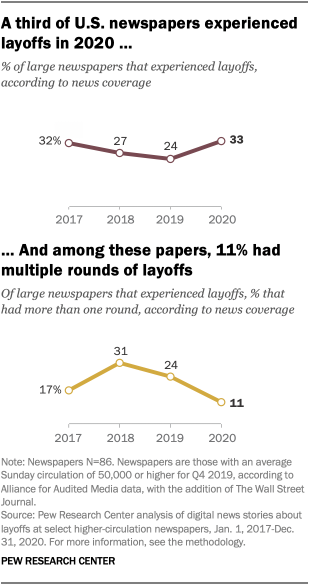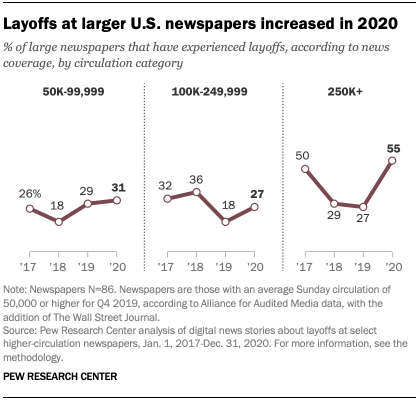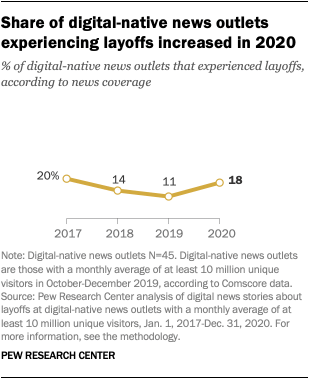Note: For the latest data on media layoffs, read our 2022 post.

Staff layoffs continued to pummel the beleaguered U.S. newspaper industry in 2020. A third of papers with an average Sunday circulation of 50,000 or more experienced layoffs last year, a period complicated by the impact of the coronavirus pandemic, according to a new Pew Research Center analysis which examined news articles that cited staff layoffs at these outlets.
These 2020 layoffs exceed the roughly one-quarter of papers in the same circulation range that experienced layoffs in 2019 (many were the same papers) as employment within the newspaper industry continued to fall precipitously in recent years.
Large-market newspapers – those with a Sunday circulation of 250,000 or more – were the most likely to suffer layoffs in 2020, with more than half of them experiencing staff cuts. That is unlike 2019, when cuts were roughly similar across the different tiers of circulation groups studied. Meanwhile, digital-native news outlets saw a slight uptick in layoffs in 2020 compared with 2019.
The analysis tallied layoffs at daily newspapers with average Sunday circulations of at least 50,000 in the fourth quarter of 2019 (as measured by the Alliance for Audited Media), as well as The Wall Street Journal, which does not report Sunday circulation to AAM. In total, there were 86 newspapers that met these criteria. Layoffs were also tallied for the 45 digital-native news outlets with a monthly average of at least 10 million unique visitors in the fourth quarter of 2019 and meeting certain criteria.
Since newspaper and digital audience data for 2020 was not yet available at the time this analysis was conducted, the same list of newspapers and digital outlets in 2019 was used for 2020. For 2018, the analysis included 97 newspapers and 37 digital-native news outlets. For 2017, it included 110 newspapers and 35 digital-native news outlets. The news articles examined did not always mention the kinds of positions eliminated, so the layoffs analyzed here were not necessarily just of newsroom employees. It is possible that more layoffs occurred but did not receive media coverage, and thus remained under the radar of the search methods employed in this analysis.
This is the latest report in Pew Research Center’s ongoing investigation of the state of news, information and journalism in the digital age, a research program funded by The Pew Charitable Trusts, with generous support from the John S. and James L. Knight Foundation.
During the coronavirus pandemic, many small and medium-sized newspaper companies were able to apply for federal aid through the CARES Act, a federal coronavirus aid package designed to help small businesses pay employees and other expenses. However, due to rules surrounding this loan program, many local newspapers owned by larger companies such as Gannett or McClatchy were not eligible to apply.
This analysis examines layoffs at large newspapers and digital-native news outlets during the 2017-2020 calendar years, but does not include other cost-cutting measures. During early days of the COVID-19 outbreak, many news media companies either delayed or avoided layoffs by first instituting cost-cutting measures such as furloughs or pay cuts.
About one-in-ten newspapers experienced multiple rounds of layoffs in 2020
Of the one-third of newspapers with an average Sunday circulation of 50,000 or higher that experienced layoffs in 2020, roughly one-in-ten (11%) experienced more than one publicly reported layoff, according to the study. By comparison, while fewer newspapers experienced layoffs in 2019, nearly a quarter (24%) of those that did have them expereniced multiple rounds of layoffs that year.
Nearly half of newspapers (46%) that experienced layoffs in 2020 also had layoffs in 2019, indicating that many of the same papers have been forced to implement layoffs multiple times in recent years.
These findings come amid reports that many small newspapers have closed due to the coronavirus pandemic and many more have sought federal aid in order to stay afloat.
Medium- and large-market newspapers saw an increase in layoffs in 2020 from 2019

Medium- and large-market newspapers – those with average Sunday circulations of 100,000 to 249,999 and 250,000 or above, respectively – experienced more layoffs in 2020 compared with 2019.
Roughly three-in-ten medium-market newspapers (27%) had publicly announced layoffs in 2020, compared with 18% in 2019. Among larger-market newspapers (those with a circulation of at least 250,000), more than half of those studied (55%) experienced layoffs in 2020. In 2019, about a quarter (27%) of larger-circulation newspapers experienced layoffs.
Smaller-market newspapers, those with a circulation between 50,000 and 99,999, experienced about the same proportion of layoffs in 2020 as 2019 (31% vs. 29%).
Layoffs at U.S. digital-native news outlets increased in 2020

Among the largest digital-native news outlets – those with a monthly average of at least 10 million unique visitors – 18% went through layoffs in 2020, up from 11% in 2019. In 2020, no digital-native news outlet that was studied experienced multiple rounds of layoffs.
While the percentage of digital-native outlets experiencing a layoff was higher in 2020 than the two years prior, it is similar to 2017, when 20% of digital-native outlets had at least one publicly announced layoff.
It is worth noting that most of the layoffs that occurred at digital-native news outlets in 2020 occurred in the latter half of the year, after the COVID-19 pandemic gripped the U.S. During the early part of the outbreak, many digital news outlets postponed or avoided layoffs entirely by first implementing pay cuts and furloughs.
Maya Khuzam and Kirsten Worden provided assistance in data analysis and content coding.
Note: Full methodology is here (PDF).
Related posts:
- Coronavirus-driven downturn hits newspapers hard as TV news thrives
- Nearly 2,800 newspaper companies received paycheck protection loans, and most were under $150K
- U.S. newspapers have shed half their newsroom employees since 2008
- Newspapers Fact Sheet
- Digital News Fact Sheet
- Newsroom employees earn less than other college-educated workers in U.S.
- Newsroom employees are less diverse than U.S. workers overall
